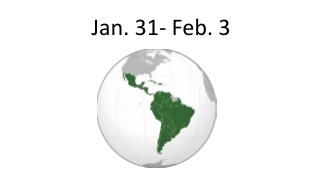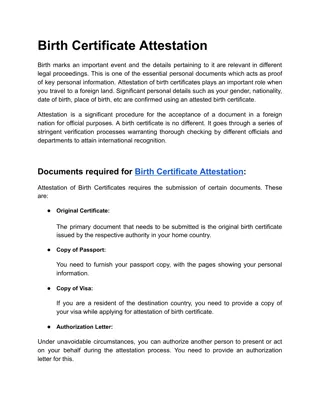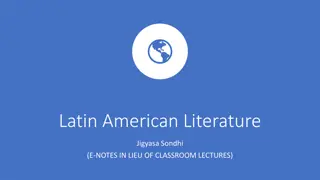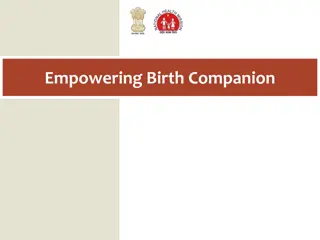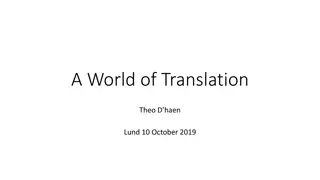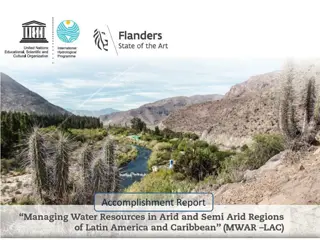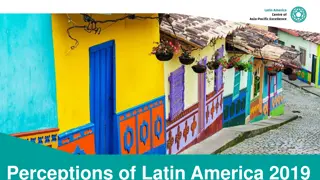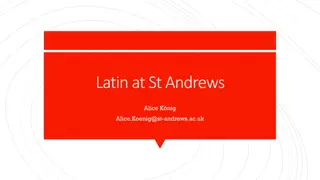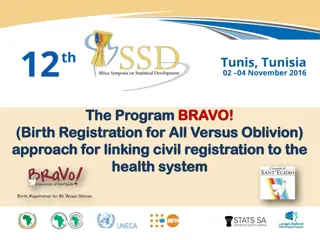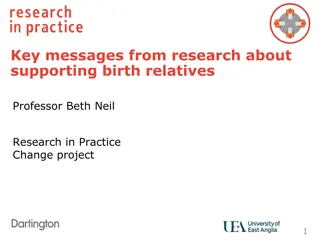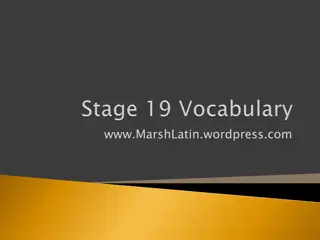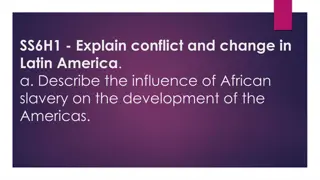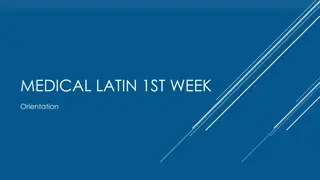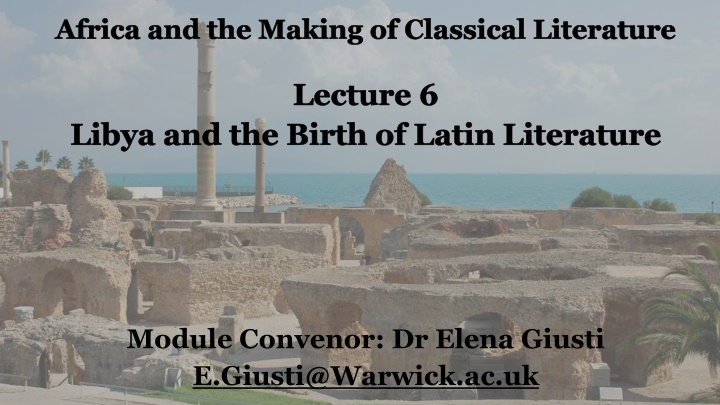
Birth of Latin Literature from African Influence
Latin literature began around 240 BCE with the adaptation of Greek dramas by Livius Andronicus during the Ludi Romani after the First Punic War. This pivotal time marked the transformation of Rome into an international power and saw the emergence of original Latin poetic works inspired by historical events. The Second Punic War further influenced Roman literature, with key events such as the battle of Cannae and the battle of Zama shaping literary creations. Explore the intriguing origins and developments of Latin literature intertwined with African and Mediterranean history.
Download Presentation

Please find below an Image/Link to download the presentation.
The content on the website is provided AS IS for your information and personal use only. It may not be sold, licensed, or shared on other websites without obtaining consent from the author. If you encounter any issues during the download, it is possible that the publisher has removed the file from their server.
You are allowed to download the files provided on this website for personal or commercial use, subject to the condition that they are used lawfully. All files are the property of their respective owners.
The content on the website is provided AS IS for your information and personal use only. It may not be sold, licensed, or shared on other websites without obtaining consent from the author.
E N D
Presentation Transcript
Africa and the Making of Classical Literature Lecture 6 Libya and the Birth of Latin Literature Module Convenor: Dr Elena Giusti E.Giusti@Warwick.ac.uk
When Did Latin Literature Begin? 240 BCE the first Latin fabula, a drama adapted from a Greek original, was produced for the Ludi Romani by Livius Andronicus; Livius Andronicus had been a Greek slave, probably captured at Tarentum in 272 and freed by a member of the Livian family; Livius wrote a number of tragedies and comedies, as well as a translation of the Odyssey in Saturnian metre, the Odusia.
Why 240 BCE? 240 BCE was the year after the end of the first Punic War (264-241 BCE), fought over the control of the Western Mediterranean, especially Sicily and Corsica. In 241 the Roman fleet, entrusted to Gaius Lutatius Catulus, achieved a decisive victory against the Carthaginians and Hamilcar Barca in the Battle of the Aegates Islands. Hamilcar negotiated a peace treaty. Corsica, Sardinia and Africa remained Carthaginian, but they had to pay a high war indemnity.
Why 240 BCE? The Ludi Romani of 240 BCE, in honour of Jupiter Optimus Maximus, must have celebrated a pivotal stage in the transformation of Rome into an international power. The First Punic War also becomes the topic of the first original poem in Latin, Gnaeus Naevius Bellum Punicum, surviving only in fragments. Naevius, a veteran of the First Punic War, was a tragedian, a comedian, and also the originator of the fabula praetexta, dramas based on Roman historical or legendary events.
In 238 BCE the Romans seize Sardinia and Corsica from the Carthaginians, in 227 BCE Sicily becomes a Roman province; the Carthaginians, or at least the Barcids, start planning a second war. In 219, with Hannibal Barca s siege of Saguntum, the Second Punic War starts. In 216 BCE, after invading Italy from the Alps, Hannibal defeats the Roman army of Lucius Aemilius Paullus and Gaius Terentius Varro in the battle of Cannae, but fails to march immediately on Rome. The war lasts until 201 BCE, after the army of Publius Cornelius Scipio (Africanus) beats Hannibal s army in the battle of Zama (202).
The Second Punic War and Roman Literature In 207 BCE, the year of the battle of of the Metaurus (when the Romans conquer the army of Hasdrubal Barca), Livius Andronicus is chosen to compose a propitiatory hymn to Juno Regina. The hymn offers the stimulus for the official establishment of a literary guild of scribae and histriones in the Aventine temple of Minerva. During the Hannibalic War, a great number of new ludi are created and old ones are extended, with dramatic performances attached. Quintus Ennius, a dramatist and satirist, and veteran of the Second Punic War, writes a foundational epic on Roman History entitled Annales, in which he includes accounts of the Hannibalic War.
The Second Punic War and Roman Literature A fragment of Porcius Licinius (2nd 1stcentury BCE) about the birth of Latin literature makes the correlation between the wars and the birth of the Latin Muse explicit: Poenico bello secundo Musa pinnato gradu intulit se bellicosam in Romuli gentem feram. (Porcius fr. 1 Courtney = Gell. Noct. 17.21.44) It was during the Second Punic War that the Muse, on her winged feet, brought herself warlike among the wild people of Romulus.
Assumptions There is a correlation between the birth of Latin literature and the Wars against Carthage. The form that this literature took was mostly dramatic; all three Roman epicists (Livius, Naevius and Ennius) were at the same time tragedians and comedians. Theatre functioned as a powerful tool to disseminate political messages among a newly formed community at Rome, but also as a means to create a feeling of shared identity against the threat of a Carthaginian invasion.
what about the Carthaginians? Carthage was a colony of Phoenician Tyre, founded sometime in the 9thcentury according to legend, by queen Dido or Elissa (Elissar) Phoenicians appear in ancient sources as early as in the Homeric poems, and play an important role in Herodotus too; they are generally stereotyped as crafty and untrustworthy traders; they are producers of sophisticated artefacts, as well as the inventors of the alphabet. In the 5thcentury they appear as the Western counterpart of the Persians. Greek sources created an artificial synchronisation of the battles of Himera (where the Sicilian tyrants Gelon and Theron defeated Hamilcar the Magonid) and Salamis (or Thermopylae) on the very same day in 480 BCE.
what about the Carthaginians? Carthaginians are also often equated to Rome in the Greek (and later Roman) imagination; their foundations are sometimes synchronized, and their political systems compared. Carthaginians must have been both Phoenician and African; in Plautus Poenulus, they are referred to as dark-skinned. Carthage must have had a vibrant literature and theatre; we know e.g. that Mago s books on agriculture were translated from Punic into Latin. Nothing survived the destruction of Carthage in 146 BCE. The city was razed to the ground and the soil was doomed by Scipio Aemilianus. A new Carthage, Colonia Iulia Concordia Carthago, would only be founded in Augustus times as a Roman colony.
List of seminar topics in Weeks 7-10 Week 7: Plautus Poenulus ( The Little Carthaginian ) Week 8: Selections from Sallust s Bellum Jugurthinum and Livy s Ab Vrbe Condita Books 21 and 30 Week 9: Virgil s Aeneid 1 and 4; selection of Horace s poems. Week 10: Selections of Lucan s Bellum Ciuile (Books 4, 9, 10) and some passages of Silius Italicus s Punica.
Bibliography for Lecture 6 Biggs, T. (2017) Primus Romanorum: Origin Stories, Fictions of Primacy, and the First Punic War, CP 112.3, 350-67. Feeney, D. (2016) Beyond Greek: The Beginnings of Latin Literature, Cambridge MA Giusti (2018) Carthage in Virgil s Aeneid: Staging the Enemy under Augustus, Cambridge, Chapter 1 Hoyos, D. (2010) The Carthaginians, London. Leigh, M. (2010) Early Roman Epic and the Maritime Moment , CPh 105.3, 265-80 Quinn, J. (2017) Translating Empire from Carthage to Rome , CPh 112.3, 312-331 --- (2018) In Search of the Phoenicians, Princeton. On the Poenulus (read by Week 7) Franko, G. F. (1996) The Characterization of Hanno in Plautus Poenulus. in AJPh 117: 425-452 Gratwick, A. S. (1971) Hanno s Punic Speech in the Poenulus of Plautus. in Hermes 99: 25-45 Slater, N. W. (1992) Plautine Negotiations: the Poenulus Prologue Unpacked , in YCS 29, 131-46

